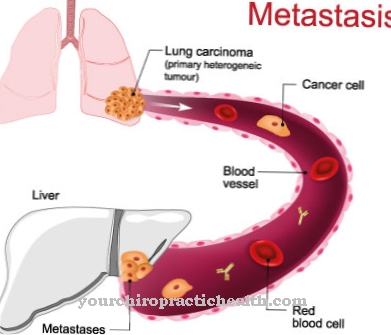Anyone who suffers from back pain caused by a herniated disc or other changes in the spine must consider very carefully whether an operation can achieve the desired relief. It is crucial not to operate too early, because a large part of the operations do not lead to the desired result. A Failed back surgery syndrome is then the result.
What is the Failed back surgery syndrome?
.jpg)
© Prostock-studio - stock.adobe.com
As Failed back surgery syndrome (also Post-Disectomy Syndrome or Post nucleotomy syndrome) refers to pain and discomfort after an operation on the intervertebral disc or spine.
The use of the English term is based on the failed operation of the back, but the Latin terms are just as common. Basically, the failed back surgery syndrome is a complication that occurs in around 30 to 50 percent of patients. The pain can initially improve immediately after the operation and then flare up again.
Sometimes there can also be a significant increase in pain. These can also radiate into the legs or the groin region and restrict the patient's mobility. There are also patients who continue to suffer from back pain immediately after the operation and who experience no improvement from the treatment and who are immediately affected by the Failed back surgery syndrome.
causes
The causes of a failed back surgery syndrome can be very diverse. In general, the decision to undergo surgery may have been made too early by the patient without waiting for the possible success of other treatments.
Another cause of the failed back surgery syndrome can be the incomplete removal of the worn-out disc pieces. An overload of the spine after the operation can also be the cause. The pain mainly occurs above and below the operated vertebral segments.
Unwanted scarring or inflammatory reactions in the surgical area lead to the failed back surgery syndrome as well as a possible instability of the entire spine.
Symptoms, ailments & signs
If the exact causes of the pain are not eliminated during a disc operation, the so-called "failed back surgery syndrome" or post-disectomy syndrome can result. In this syndrome, the back pain that was already present before the surgical procedure and which radiates into one leg either persists or flares up again shortly after the operation.
Furthermore, the pain can even increase as a result of the operation and also radiate into the groin or legs. Pain is possible anywhere in the spine. Depending on the cause, these are perceived as burning, electrifying, pulling, dull or locally oppressive. Due to the involvement of the nervous system, tingling, nocturnal calf cramps or an uncomfortable feeling of cold also often occur.
Especially when bending over, there is often unbearable pain. Furthermore, the "failed back surgery syndrome" can also lead to long-term effects. These manifest themselves, among other things, in an instability of the spine, increased formation of connective tissue near the spinal cord, adhesions of the spider tissue skin of the spinal cord or in a repeated herniated disc.
Complete freedom from pain can no longer be achieved even with intensive drug and physical therapies. Physical therapy aims to stabilize the spine over the long term. The drug therapies have a calming effect on the nervous system. However, the nerve irritation is chronic, so that only lengthy and complex treatment methods can gradually reduce pain and thus improve quality of life.
Diagnosis & course
Failed back surgery syndrome can be diagnosed with imaging tests. These include MRI (magnetic resonance imaging) and CT (computed tomography). However, the results of these examination methods with regard to the failed back surgery syndrome should be carefully evaluated with regard to a follow-up operation, since other treatment options should be tried beforehand.
The development of pain in failed back surgery syndrome often takes a chronic course. The main focus should then be on adequate pain management. The support of a psychologist can also help to deal with the persistent pain of the failed back surgery syndrome.
Complications
In many operations, the so-called failed back surgery syndrome occurs, which can lead to considerable complaints and complications in the patient's everyday life. This usually results in extremely severe pain in the back. These pains are primarily stabbing and can spread to other regions of the body and cause pain or unpleasant feelings there.
It is not uncommon for the failed back surgery syndrome to also lead to sensory disturbances and sensitivity disturbances throughout the body. Muscle weakness also occurs and the person feels tired and exhausted. Paralysis also occurs, which usually leads to restricted mobility and, in general, to severe restrictions in the patient's everyday life. Not infrequently, these complaints also lead to depression or further psychological upsets.
There are no further complications with the treatment itself. This takes place primarily through various therapies and can alleviate the symptoms. However, a positive course of the disease is not always possible, so that not all pain can be completely limited. If the pain caused by the failed back surgery syndrome also occurs at night, this can lead to sleep disorders.
When should you go to the doctor?
Failed back surgery syndrome must always be examined by a doctor. This disease usually does not heal itself and in most cases unfortunately the symptoms worsen. Because of this, early diagnosis and treatment of the disease can prevent further complications. The doctor should be consulted if there is severe pain in the back.These pains are often stabbing and spread to neighboring regions. There are also sensory disturbances or paralysis.
Possible muscle weakness can also indicate the disease and should be examined by a doctor. Failed back surgery syndrome can be diagnosed and treated by an orthopedic surgeon or a physiotherapist. In many cases, this can significantly reduce pain and restricted mobility. However, many of those affected are also dependent on psychological treatment.
In the event of acute emergencies or very severe pain, a hospital can also be visited. There the pain can be relieved directly with the help of anesthetics. Painkillers, however, should not be taken over a long period of time in order not to damage the stomach and to avoid becoming dependent.
Doctors & therapists in your area
Treatment & Therapy
The treatment of Failed back surgery syndrome is mainly about relieving the pain that is present and thereby minimizing the restriction of movement. In terms of treatment options, physiotherapeutic applications come first. These include above all physiotherapy and transcutaneous electrical nerve stimulation (TENS).
In physiotherapy under the guidance of a therapist, the muscles of the back should first be strengthened. In addition, the patient affected by the failed back surgery syndrome learns exercises that should help him to avoid bad posture and the resulting incorrect stress on the back in everyday life. Electrostimulation (TENS) can easily be continued by the patient at home. The device generates a safe current that stimulates muscles and nerves, thereby relieving pain.
Heat and cold therapy is also used to relieve pain caused by the failed back surgery syndrome. This procedure can also be done before physiotherapy, as it optimally prepares the muscles for treatment. With relaxation techniques such as autogenic training, patients can learn to better deal with the pain of the failed back surgery syndrome.
Acupuncture treatments also help with pain relief. However, the adequate administration of painkillers and, if necessary, muscle-relaxing medication is also very important. A temporary relief of the pain in failed back surgery syndrome can also be achieved by the local injection of anesthetics at certain pain points by the doctor.
Outlook & forecast
In the case of failed back surgery syndrome, as a rule, no general statement can be made about the further prospect and prognosis of the disease, as these mostly depend on the exact symptoms. However, if the failed back surgery syndrome is not treated, there is usually no improvement in the symptoms and significant restrictions in the life and everyday life of the patient.
The person affected is dependent on the help of other people and can usually no longer cope with everyday life on their own. As a rule, some symptoms of the syndrome can be relieved with the help of physiotherapy and physiotherapy. Many of the exercises can also be performed in your own home to accelerate and promote healing.
In the case of the failed back surgery syndrome, however, the patient is still dependent on taking painkillers and narcotics, as the pain is usually very strong. Another operation is often necessary to permanently alleviate the symptoms and make the patient's life easier. Treatments with the help of electrical stimulation can also alleviate the symptoms, although complete healing can usually not be achieved.
prevention
Preventing failed back surgery syndrome is very important. First, all conventional treatment options for back pain should be exhausted and the pain should be relieved with specific medication. An operation should only be attempted if all of the above measures are unsuccessful and the pain is unbearable. Ultimately, it should be borne in mind that around half of all back operations result in a failed back surgery syndrome.
Aftercare
Follow-up care options have proven to be relatively difficult in most cases of failed back surgery syndrome. A complete cure of this disease cannot always be achieved, whereby the further course depends very much on the exact complaints and their severity. As a rule, the life expectancy of the person affected is not restricted by the Failed back surgery syndrome.
The syndrome is usually treated through physiotherapy or various types of physiotherapy massage. Some of the exercises from physiotherapy and physiotherapy can also be carried out in your own home in order to increase the mobility of the body again and to alleviate the symptoms. When taking painkillers, the person concerned should always pay attention to the maximum dose and not take too many painkillers over a long period of time.
If anything is unclear, a doctor should be consulted to prevent further complications and interactions. Stress should also be avoided in the failed back surgery syndrome. The person affected can use various relaxation techniques to alleviate the symptoms, although some self-help options are also available to limit the symptoms.
You can do that yourself
In order to improve well-being, the person affected should control his movement sequences and initiate changes. One-sided loads, excessive strain and strong physical tension are to be avoided. Regular exercise and an ergonomic sitting posture can reduce discomfort.
The dead weight should be in the normal range according to the BMI specifications. Obesity should be avoided as it leads to complications and severe health impairments. The diet should be rich in vitamins and balanced. Unhealthy foods, the consumption of nicotine or alcohol harm the patient and should be avoided. The use of rigid postures is also not advisable.
Compensating movements of the entire body are important. Care must be taken that nerves and vessels are not pinched. You should generally refrain from wearing high-heeled shoes. They increase the general risk of accidents and lead to changes in natural motion sequences.
In everyday life, it is important to maintain a healthy posture when lifting, carrying or holding onto objects. Heavy objects in particular should not be moved without assistance. Sudden turning movements or jerky movements are to be avoided, as they often trigger immediate symptoms. On the other hand, a sufficient supply of heat to the back and a straight posture, which helps stabilize the natural body structure, are helpful.

.jpg)

























